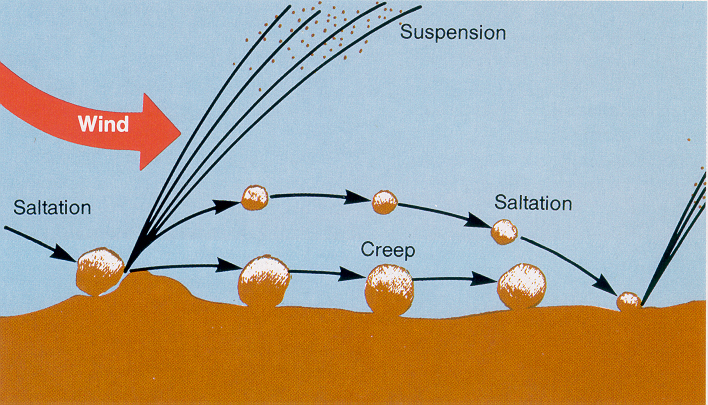
Current version of the WEPS Technical Documentation (1996)
(pdf format - requires a PDF reader)
WEPS related publications as of 2013
(pdf format - requires a PDF reader)
WEPS 1.5 User's Manual
(pdf format - requires a PDF reader)
Download a slide show about the Wind Erosion Prediction System presented at the 2005 IECA Conference.
Wind erosion is a serious problem on agricultural lands throughout the United States as well as the world. The ability to accurately predict soil loss by wind is essential for, among other things, conservation planning, natural resource inventories, and reducing air pollution from wind blown sources.
The USDA appointed a team of scientists to take a leading role in combining the latest in wind erosion science and technology with databases and computers, to develop what should be a significant advancement in wind erosion prediction technology. The Wind Erosion Prediction System (WEPS) incorporates this new technology and is designed to be a replacement for WEQ.
Unlike WEQ, WEPS is a process-based, continuous, daily time-step model that simulates weather, field conditions, and erosion. It is a user friendly program that has the capability of simulating spatial and temporal variability of field conditions and soil loss/deposition within a field. WEPS can also simulate complex field shapes, barriers not on the field boundaries, and complex topographies. The saltation, creep, suspension, and PM10 components of eroding materials can also be reported separately by direction in WEPS. WEPS is designed to be used under a wide range of conditions in the U.S. and easily adapted to other parts of the world.

Soil erosion by wind is initiated when wind speed exceeds the saltation threshold velocity for a given field condition. After initiation, the duration and severity of an erosion event depends on the wind speed distribution and the evolution of the surface condition. Because WEPS is a continuous, daily, time-step model, it simulates not only the basic wind erosion processes, but also the processes that modify a soil's susceptibility to wind erosion.
The structure of WEPS is modular and consists of a user-interface, a MAIN (supervisory) routine, seven submodels, and four databases. Most of the submodels within WEPS use daily weather (from the WEATHER submodel) as the natural driving force for the physical processes that change field conditions. The HYDROLOGY submodel accounts for changes in temperature and water status of the soil. Changes in the soil properties between management events are simulated in the SOIL submodel. The growth of crop plants is simulated in the CROP submodel, and their decomposition is accounted for in the DECOMPOSITION submodel. Step changes in the soil and biomass conditions generated from typical management practices such as tillage, planting, harvesting, and irrigation are modeled within the MANAGEMENT submodel of WEPS. Finally, the power of the wind on a subhourly basis is used to drive the EROSION submodel.